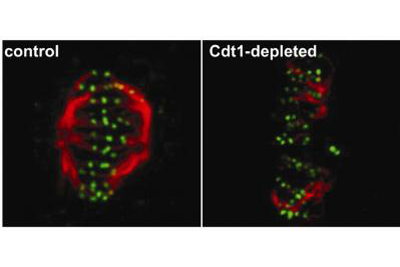DNA Replication Protein Caught Working Second Job

This Research in Action article was provided to LiveScience in partnership with the National Science Foundation.
Although our cells have many different purposes, they adhere to the same general agenda — the cell cycle. Over four phases, cells grow, copy their genetic material and divide.
Helping the process is a plethora of proteins, each with a specific job in the cell’s intricate reproductive process. If a protein isn’t at the right place at the right time, the resulting new cells can have mutations that get passed on and on.
Disruption in cell cycle control is associated with degenerative diseases of the heart and nervous system as well as many types of cancer.
The above pictures show two tales of cell division. Both cells are in the cell cycle phase of mitosis, when copied chromosomes align in the middle of the spindle. The spindle, a structure that divides genetic material between daughter cells, has rope-like microtubules (red) attached to proteins near the middle of chromosomes (green). The image on the left shows an intact spindle, and the image on the right shows a collapsed one.
A protein previously thought to play a role only in DNA replication, which happens earlier in the cell cycle, also helps the spindle make stable chromosome attachments during mitosis.
Researchers at the University of North Carolina at Chapel Hill learned that the protein, Cdt1, aids another protein, Hec1, which is involved in distributing copied chromosomes evenly between the new cells. When Cdt1 was eliminated from the cells before mitosis, Hec1 no longer could do its job properly. This insight into the role of Cdt1 could lead to new therapies for diseases associated with improper cell division.
Sign up for the Live Science daily newsletter now
Get the world’s most fascinating discoveries delivered straight to your inbox.
This research was supported by the National Institutes of Health. To see more images and videos of basic biomedical research in action, visit the Biomedical Beat Cool Image Gallery.
Editor's Note: Any opinions, findings, and conclusions or recommendations expressed in this material are those of the author and do not necessarily reflect the views of the National Science Foundation. See the Research in Action archive.










